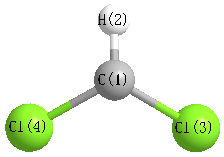Jump to
S1C2
Energy calculated at CCSD(T)/aug-cc-pVTZ
| | hartrees |
|---|
| Energy at 0K | -958.044047 |
| Energy at 298.15K | |
| HF Energy | -957.449295 |
| Nuclear repulsion energy | 125.737407 |
The energy at 298.15K was derived from the energy at 0K
and an integrated heat capacity that used the calculated vibrational frequencies.
Vibrational Frequencies calculated at CCSD(T)/aug-cc-pVTZ
| Mode Number |
Symmetry |
Frequency
(cm-1) |
Scaled Frequency
(cm-1) |
IR Intensities
(km mol-1) |
Raman Act
(Å4/u) |
Dep P |
Dep U |
|---|
| 1 |
A1 |
3267 |
3168 |
|
|
|
|
| 2 |
A1 |
754 |
732 |
|
|
|
|
| 3 |
A1 |
307 |
298 |
|
|
|
|
| 4 |
B1 |
409i |
397i |
|
|
|
|
| 5 |
B2 |
1232 |
1195 |
|
|
|
|
| 6 |
B2 |
930 |
902 |
|
|
|
|
Unscaled Zero Point Vibrational Energy (zpe) 3040.4 cm
-1
Scaled (by 0.9699) Zero Point Vibrational Energy (zpe) 2948.9 cm
-1
See section
III.C.1 List or set vibrational scaling factors
to change the scale factors used here.
See section
III.C.2
Calculate a vibrational scaling factor for a given set of molecules
to determine the least squares best scaling factor.
Geometric Data calculated at CCSD(T)/aug-cc-pVTZ
Point Group is C2v
Cartesians (Å)
| Atom |
x (Å) |
y (Å) |
z (Å) |
|---|
| C1 |
0.000 |
0.000 |
0.676 |
| H2 |
0.000 |
0.000 |
1.752 |
| Cl3 |
0.000 |
1.474 |
-0.171 |
| Cl4 |
0.000 |
-1.474 |
-0.171 |
Atom - Atom Distances (Å)
| |
C1 |
H2 |
Cl3 |
Cl4 |
| C1 | | 1.0758 | 1.7003 | 1.7003 |
H2 | 1.0758 | | 2.4231 | 2.4231 | Cl3 | 1.7003 | 2.4231 | | 2.9486 | Cl4 | 1.7003 | 2.4231 | 2.9486 | |
 More geometry information
More geometry information
Calculated Bond Angles
| atom1 |
atom2 |
atom3 |
angle |
|
atom1 |
atom2 |
atom3 |
angle |
| Cl3 |
C1 |
H2 |
119.883 |
|
Cl3 |
C1 |
Cl4 |
120.234 |
| Cl4 |
C1 |
H2 |
119.883 |
|
Electronic energy levels
Charges, Dipole, Quadrupole and Polarizability
Jump to
S1C1
Energy calculated at CCSD(T)/aug-cc-pVTZ
| | hartrees |
|---|
| Energy at 0K | -958.045125 |
| Energy at 298.15K | -958.045953 |
| HF Energy | -957.450928 |
| Nuclear repulsion energy | 125.591899 |
The energy at 298.15K was derived from the energy at 0K
and an integrated heat capacity that used the calculated vibrational frequencies.
Vibrational Frequencies calculated at CCSD(T)/aug-cc-pVTZ
| Mode Number |
Symmetry |
Frequency
(cm-1) |
Scaled Frequency
(cm-1) |
IR Intensities
(km mol-1) |
Raman Act
(Å4/u) |
Dep P |
Dep U |
|---|
| 1 |
A' |
3227 |
3130 |
|
|
|
|
| 2 |
A' |
765 |
742 |
|
|
|
|
| 3 |
A' |
522 |
506 |
|
|
|
|
| 4 |
A' |
303 |
294 |
|
|
|
|
| 5 |
A" |
1243 |
1206 |
|
|
|
|
| 6 |
A" |
899 |
872 |
|
|
|
|
Unscaled Zero Point Vibrational Energy (zpe) 3479.1 cm
-1
Scaled (by 0.9699) Zero Point Vibrational Energy (zpe) 3374.4 cm
-1
See section
III.C.1 List or set vibrational scaling factors
to change the scale factors used here.
See section
III.C.2
Calculate a vibrational scaling factor for a given set of molecules
to determine the least squares best scaling factor.
Geometric Data calculated at CCSD(T)/aug-cc-pVTZ
Point Group is Cs
Cartesians (Å)
| Atom |
x (Å) |
y (Å) |
z (Å) |
|---|
| C1 |
0.012 |
0.703 |
0.000 |
| H2 |
-0.499 |
1.653 |
0.000 |
| Cl3 |
0.012 |
-0.173 |
1.469 |
| Cl4 |
0.012 |
-0.173 |
-1.469 |
Atom - Atom Distances (Å)
| |
C1 |
H2 |
Cl3 |
Cl4 |
| C1 | | 1.0792 | 1.7105 | 1.7105 |
H2 | 1.0792 | | 2.3989 | 2.3989 | Cl3 | 1.7105 | 2.3989 | | 2.9389 | Cl4 | 1.7105 | 2.3989 | 2.9389 | |
 More geometry information
More geometry information
Calculated Bond Angles
| atom1 |
atom2 |
atom3 |
angle |
|
atom1 |
atom2 |
atom3 |
angle |
| Cl3 |
C1 |
H2 |
116.790 |
|
Cl3 |
C1 |
Cl4 |
118.428 |
| Cl4 |
C1 |
H2 |
116.790 |
|
Electronic energy levels
Charges, Dipole, Quadrupole and Polarizability
